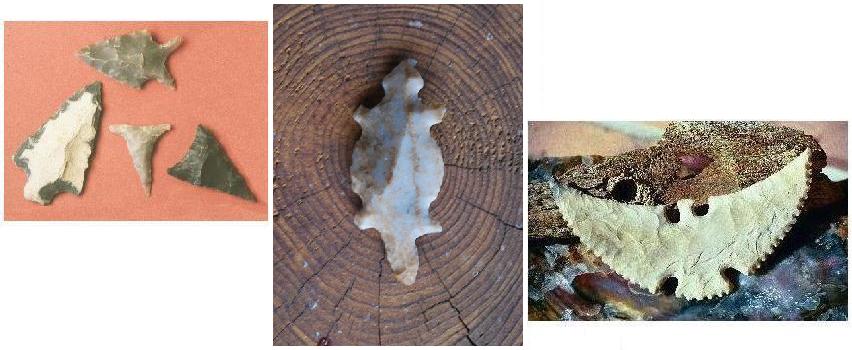( Fr- silexite/silex
corné;
Ger-
Hornstein/Feuerstein; Nor- flint(e); Rus-
![]() )
)
CHERT, SiO2. (See also CHALCEDONY, FOSSILIFEROUS ROCKS, and JASPER entries.)

Left to right:
A. Chert. Native American arrow heads
(one on lower left, length - ca.
3.5 cm) collected in Michigan. (© photo by D.L. Brittain)
DESCRIPTION: Chert is the name given to
some microcrystalline quartz -- see following discussion under Colors.
Colors - typically white, diverse gray hues,
black, brown or yellowish, and rarely red, pink, yellow, green
or blue; uncommonly banded. Color sometimes leads to problems so
far as designating a given material chert rather than jasper;
indeed, some people consider jasper to be a colored variety of
chert. A "rule of thumb" -- albeit based on a subjective
criterion -- that I subscribe to is "if the
specimen exhibits so-to-speak attractive colors call it jasper,
otherwise call it chert." In addition, distinguishing some cherts
and jaspers from some chalcedony also requires subjective decisions.
H. 7
S.G. 2.55-2.65
Light transmission - subtranslucent to
opaque
Luster - dull to porcelaneous, pearly or
even subvitreous
Breakage - splintery to
conchoidal fracture
Miscellany - most chert, especially that
widely called flint, is triboluminescent.
OTHER NAMES: To many geologists, the term chert includes rocks frequently called flint and hornstone as well as some jasper. Some chert comprises units with extents that have led to their being given formal stratigraphic unit designations (see Appendix B, Glossary). Two examples are the Fort Payne Chert of the southern Appalachians and the Huntersville Chert of West Virginia, Tennessee, Kentucky, and Virginia. For the several terms that have been applied to chert, see Hart (1927) as well as those that follow:
USES: Cabochons for pendants and bracelets; tumbled for use in necklaces, bracelets, etc.; slabbed and polished for such things as paperweights. In addition, flint arrowheads may be considered gemrocks because they are used widely as pendants, bolo slides, etc. Although novaculite's primary use is as a hone or whetstone, it also has been fashioned, albeit infrequently, into diverse ornaments.
OCCURRENCES: Common as layers or nodules in limestone, including chalk, and dolostone formations.
NOTEWORTHY LOCALITIES: Widespread in sedimentary rock terrains, especially those that include limestone and/or dolostone formations. Three United States of America examples have been recorded as especially noteworthy: Flint Ridge, which extends eastward from near Newark, Licking Creek County almost to Zanesville, Muskingum County, Ohio (Anonymous, 1974) [Also, a DVD, which I have NOT seen, about this locality was released in 2008 -- it is said to have illustrations showing hundreds of artifacts. Be forewarned that it has received mixed review. I suspect its availability can be found on the internet.] the area north of Utica, LaSalle County, Illinois (Mori, 1980); [and] near Yellville, Marion County, Arkansas (where a banded chert that takes an especially fine polish (etc.) occurs -- see Trout (1983). In addition, some fine "arrowhead replicas" have recently been fashioned from a reddish brown and off-white streaked chert from near Glendo, Wyoming.
REMARKS: Derivation of the term chert so
far as its application to this cryptocrystalline variety of quartz is
shrouded in, I suspect, the mists of 17th century England. In any
case, it [i.e.,
chirts] was applied to chert masses in chalk in Staffordshire in
the literature by the 1680s (O.E.D.) Use of the term flint, long
applied to "hard stone" in general, had even more ancient roots -- at
least so far as its use in the literature; the diverse materials
to which it was been applied are too numerous to review here; for
a brief review, see the Oxford English Dictionary.
Although flint is chert is flint is chert . . . etc., some people make the hardly useful or valid distinction that flint occurs as nodules whereas chert constitutes layers or beds. But, as any geologist who has worked with these rocks knows, even though some chert/flint may be described as having one rather than the other of these occurrences, others cannot. In fact, chert/flint-bearing calcareous rocks commonly grade from zones containing sporadic flint/chert nodules to zones with interbeds of chert/flint.
Flint weapons and tools were made during the "Stone age" in several places in Great Britain and continental Europe (Shepherd, 1972). An artifact in the Oriental Institute collections of the University of Chicago bears the following label/caption: "IRAN: Persepolis - Tripod Bowl of Green Polished Chert, Achaemenid. From the Treasury" is shown on the internet (www-oi.uchicago.edu); to date, however, I have been unable to gain further information about this piece. Flint tools made by Native Americans from chert from Flint Ridge, Ohio have been found as far away as "on the Atlantic seaboard, in Louisiana, and as far west at Kansas . . . and [this chert is also said to have been] of vital importance to early Ohio settlers, who used it for starting fires and in flintlock guns, which were in use for two hundred years. [Furthermore,] a porous form of the rock was used for buhrstones to grind grain in early mills." (Anonymous, 1974).
Flint, as represented by the rather colorful
material from Flint Ridge, Licking County, is the official gemstone of
Ohio, and Mozarkite, which is a varicolored (red, purple,
green
and reddish brown) chert that is fairly common in the Ozarks,
especially in Benton County, is the official state rock of
Missouri.
SIMULANTS: None that I have seen or seen described.
REFERENCES: No general reference. Anonymous, 1974; Shepherd, 1972.
R. V. Dietrich © 2015
Last
update: 13 October 2012
web page created by Emmett Mason